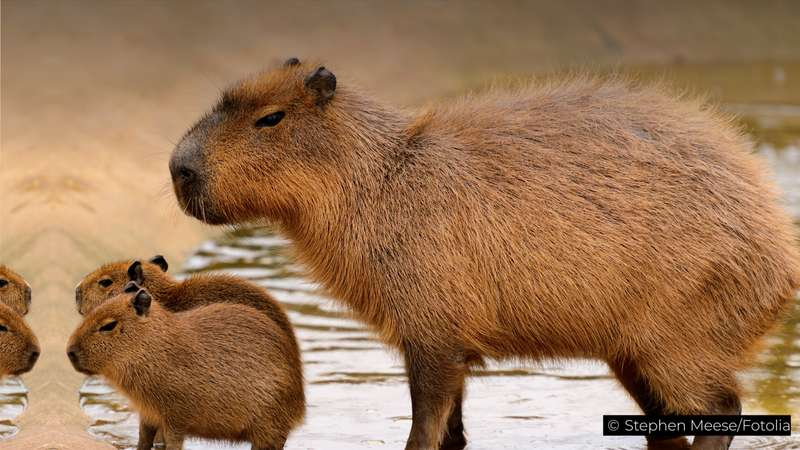
I'm thrilled to present my first first-author paper on the evolution of gigantism in the #capybara, the world's largest rodent! 😃 Thanks to co-authors @CrawfordAJ @eenork @frozenzoo @OfficialSMBE #MBE #cienciacriolla 🧶👇 1/21 bit.ly/3mmgqlp 

Body size evolution is central in biology. We know that body size co-evolves with many organismal traits (e.g. longevity, home range 🏠, generation time ⏰, predation risk, organ allometries 💪, etc.) within and between spp.
2/21
2/21
Yet, we know little about how body size itself evolves 🧐. For instance, body size in mammals varies over 8 orders of magnitude! 🤯
3/21
3/21

Further, gigantism has evolved several times in different animal lineages. But, the existence of giants is an evolutionary puzzle 🤔
4/21
4/21
https://twitter.com/Extinct_AnimaIs/status/1314524650114879488
1) the genetic 🧬and developmental factors that underly body size variation between spp 🐭🦥🐘🐳 are unclear, and
5/21
5/21

2) theory predicts the evolution of giants to be constrained by 2 tradeoffs: a) larger species have smaller population sizes (Ne) 📉, and may accumulate more slightly deleterious mutations 🧬⚡️, making them prone to extinction ☠️
6/21
6/21
and b) larger animals have more cells, so they should have a higher lifetime risk of developing cancer 😰 relative to smaller animals, everything else being equal. So, how can giants evolve and persist?! 🧐
7/21
7/21

Now, please welcome, from the wetlands of South America 🌎, the amazing #capybara, the world's largest living rodent 🐭: an adult capybara weighs ~120 lb (55 Kg), being 2,000x bigger than a mouse 🤯. But, can they be considered giants?
8/21
8/21

We found that capybaras evolved from a small ancestor (~1 Kg) and their huge size involved an acceleration in the rate of body mass evolution (BME)⏱️. Also, the tempo and mode of BME were similar to that of elephants 🐘, baleen whales 🐳 , and sauropod dinosaurs 🦕!
9/21
9/21

Then, using comparative genomics 🧬 with 16 available rodent genomes 🐭🐹🐀, we embarked to explore the genetic basis of gigantism in the capybara 🧐, and the genomic signatures of the two evolutionary tradeoffs related to the evolution of gigantism.
11/21
11/21
1) our analyses pointed to several genes within 2 major developmental pathways: the insulin/ins-like growth signaling (IIS) and transforming growth factor-b signaling (TGFbS) pathways. Both, known to control post-natal bone growth 🦴 and musculoskeletal development 💪!
12/21
12/21

IIS ⬆️ cell proliferation and TGFbS regulates chondrocyte proliferation and differentiation during the development of the skeleton 🦴🧬. Together they might maintain an active population of chondrocytes in the growth plates allowing for bone growth
13/21
13/21

*IIS has been linked to extreme body size evolution in the sunfish, the world’s largest extant bony fish 🐟, and to extreme size differences in dog breeds 🐕. Thus, ISS could be a hotspot 🔴 for body size evolution among vertebrates!
14/21

14/21


2) we found that the capybara has a higher genome-wide dN/dS 🧬⬆️, consistent with an accumulation of slightly deleterious mutations due to a reduction in Ne caused by the increase in body size
15/21
15/21

3) we found that growth pathways (IIS and TGFbS) are enriched in cancer pathways! 🤯 Actually, 8/11 genes in the growth pathways are known to be important oncogenes in several cancers
16/21
16/21

This suggests that the evol of gigantism should be coupled with the evol of anticancer mechanisms 🤔. In fact, there is no correlation between size and cancer risk across spp. This is known as #PetosParadox 😮. We looked for potential anticancer adaptations in the capybara.
17/21
17/21

Surprisingly, we found an expansion of MAGEB5 genes in the capybara. MAGEB5 are expressed when cells become cancerous ☠️ and may be recognized by cytotoxic T lymphocytes triggering a T-cell mediated tumor suppression response 🚨📡
18/21
18/21

This might explain how the capybara solved the increased risk of cancer due to an increase in body size, however, functional data are required to confirm this hypothesis 🔬🧫
19/21
19/21
The evolution of gigantism is a very complex evol. phenomenon but offers an excellent opportunity to study how the interaction between population-level and developmental processes shapes phenotypic diversity 🤓🐭🦁🦊🦌
20/21
20/21

*Bonus* Inspired by @Valeria_RamCas recent work, the full main text in Spanish can be found in the Supplementary Material Online 🥳
21/21
21/21
Thanks @n8_upham for sharing with us your phylogeny! 🤙
And Kerstin Lindblad-Toh (not on Twitter). Also, thanks to the @ZoonomiaProject for collaborating with us on this journey 🧬🤙 #openaccess #genomics
and @MincienciasCo!
• • •
Missing some Tweet in this thread? You can try to
force a refresh



